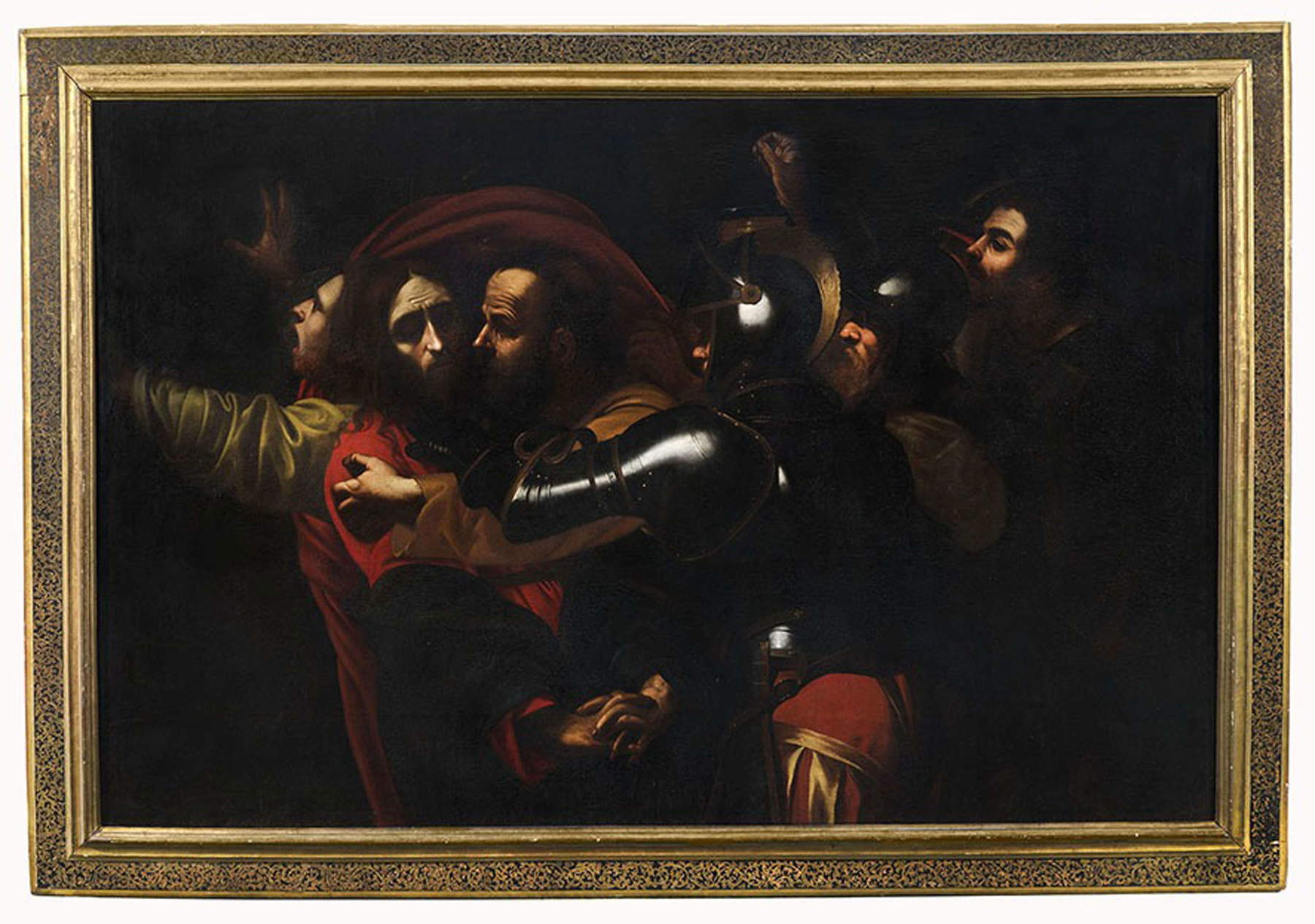After a series of exhibitions that attracted more than a hundred thousand visitors between 2023 and 2024, the Taking of Christ formerly in the Ruffo Collection, a work attributed to Caravaggio, returns to Ariccia, where it was already exhibited at the end of 2023, but this time it finds a permanent location. In fact, the painting will be exhibited for at least five years at Palazzo Chigi thanks to an agreement between the municipality and antiquarian Mario Bigetti, the work’s owner. The five-year agreement provides for the free loan of the painting, which can no longer be admired as a temporary loan but as an integral part of the picture gallery of the historic residence.
The decision was ratified by a decree of the Ministry of Culture, General Directorate of Archaeology, Fine Arts and Landscape, signed on September 10, 2025 by the Superintendent for the Metropolitan Area of Rome and the Province of Rieti, Lisa Lambusier. The painting, which was already notified in 2004 by the Italian state as an asset of national interest, thus re-enters a museum context consistent with its history. It will be exhibited in the Sala Borghese on the piano nobile of Palazzo Chigi, not as an isolated work in a temporary exhibition, but as a key element of an arrangement that evokes the atmosphere of seventeenth-century picture galleries. The return to Ariccia ideally closes a cycle that began with the major exhibition of 2023-24, which had as its centerpiece precisely the painting from the Ruffo Collection. The exhibition, mounted at Palazzo Chigi, registered an exceptional turnout, which was followed by stops in Naples, at the headquarters of the Fondazione Banco di Napoli, in Salerno, at the Complesso San Michele, and finally in Gorizia at the Fondazione Cassa di Risparmio. The four exhibitions together garnered more than one hundred thousand visitors, confirming the strong appeal exerted by the masterpiece attributed to Merisi.
The attribution to the Lombard painter has long been supported by numerous scholars. As early as its reappearance in 2003, the painting was recognized as autograph by authorities in the field such as Denis Mahon, Mina Gregori and Maurizio Marini, who in turn referred to a positive assessment formulated as early as 1943 by Roberto Longhi. Later, the list of supporters expanded with contributions from Vincenzo Pacelli, John T. Spike, Clovis Whitfield, Anna Coliva, and many other art historians. In the 2023 exhibition catalog, edited by Francesco Petrucci, a thorough and systematic study was conducted that further strengthened the attribution.

Several elements contribute, according to favorable scholars, to consolidate the autograph hypothesis: the very rare original “black aubescata d’oro” frame, described in the inventories of the Mattei collection from which the painting comes, the presence of pentimenti and variations that emerged from diagnostic investigations, the larger size and composition compared to the other known versions, and above all the pictorial quality, with specific characteristics that match Caravaggio’s language.
The debate over the work’s authorship has been intertwined with the discussion around the version preserved in Dublin, which is on display in this year’s Roman exhibition. Unfortunately, during Caravaggio 2025 (this was the title of the exhibition held at Palazzo Barberini), the Dublin version was protected by glass and could not be photographed (this painting and the formerly Ansorena’sEcce Homo were the only paintings for which there was a prohibition, which was strictly enforced because both works had two attendants in charge of guarding them on sight, preventing anyone from approaching them to take photos). In addition, the total absence of diagnostic data on the painting’s condition before restoration and the smoothness of the surface, judged unusual for Caravaggio, have fueled perplexity among scholars. The failure to mention the Ruffo canvas in the exhibition catalog, an issue raised by Federico Giannini in the pages of Finestre sull’Arte, caused further surprise, since the Palazzo Barberini exhibition was organized after the “tour” of the Ruffo version and a direct comparison that could have clarified the relationship between the two versions would have been interesting.
Now, with the return to Palazzo Chigi, the public will be able to see the Taking of Christ again in the context of a historic home, in a setting that recalls the Mattei and Ruffo palaces where the work was originally located. The exhibition in the Borghese Room also fits into a tradition that links Ariccia to Caravaggio’s painting. Indeed, in the past the Savelli palace held The Denial of Peter, now at the Metropolitan Museum in New York, as well as numerous canvases by Orazio and Artemisia Gentileschi. Merisi’s presence thus restores a reminder of the richness of the Caravaggesque picture gallery that characterized the palace in the early decades of the seventeenth century.
The painting’s permanent return to Ariccia not only represents an important milestone in the enhancement of the local artistic heritage, but also offers a unique opportunity to admire one of the most discussed and fascinating paintings in the Caravaggesque catalog. Harmoniously inserted in the architectural and decorative setting of Palazzo Chigi, the masterpiece returns to dialogue with the space and historical memory of the city, thus continuing a path that combines research, protection and public accessibility.
Palazzo Chigi in Ariccia can be visited from 10 a.m. to 1 p.m. and 3 to 6 p.m. from Oct. 1 to March 30, and from 10 a.m. to 1 p.m. and 3:30 to 6:30 p.m. from April 1 to Sept. 30.
 |
| Caravaggio, The Taking of Christ will be permanently displayed in Ariccia: five-year agreement |
Warning: the translation into English of the original Italian article was created using automatic tools. We undertake to review all articles, but we do not guarantee the total absence of inaccuracies in the translation due to the program. You can find the original by clicking on the ITA button. If you find any mistake,please contact us.